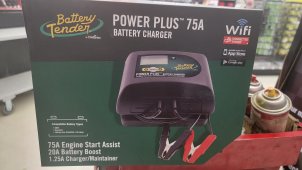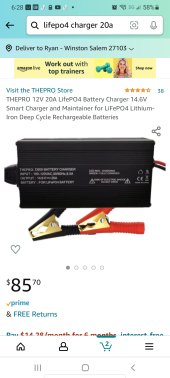RyanNicholas
New Member
- Joined
- Dec 18, 2020
- Messages
- 89
Hi everyone. This might be a bit of a noob question to ask, but you guys are generally pretty supportive for people on the learning curve, so here goes.
I've been operating for the last year on the battery I built, which is a 280ah 4s 12v with a BMS from Current Connected (just like the overkill solar ones). It's been working great... but the sun has been pretty low lately, and it has me curious about something.
I would love to be able to charge this battery occasionally on an external power supply, hopefully without having to disconnect anything. If I hook up, say, a standard 12 volt auto battery charger to it, will that work effectively and safely to juice me up? I realize that, when fully charged, the voltage on this battery is closer to 14 than 12 - so it's just had me wondering if trying to juice up on just 12 volts is enough. And, if it would indeed work, could I just hook it right up to the main access terminals with everything else still connected to them? Since I'm not set up like an RV for 'shore power' connection, it's doing what I'm suggesting is a viable option, it would be super nice to be able to hook up a trickle charger overnight at my buddy's house while I'm parked overnight ( without having to completely lose power in the meantime). My amp hours have dwindled over the last couple of days, I just installed a diesel heater, and we're expecting snow this weekend.
Thanks in advance for any helpful advice!
I've been operating for the last year on the battery I built, which is a 280ah 4s 12v with a BMS from Current Connected (just like the overkill solar ones). It's been working great... but the sun has been pretty low lately, and it has me curious about something.
I would love to be able to charge this battery occasionally on an external power supply, hopefully without having to disconnect anything. If I hook up, say, a standard 12 volt auto battery charger to it, will that work effectively and safely to juice me up? I realize that, when fully charged, the voltage on this battery is closer to 14 than 12 - so it's just had me wondering if trying to juice up on just 12 volts is enough. And, if it would indeed work, could I just hook it right up to the main access terminals with everything else still connected to them? Since I'm not set up like an RV for 'shore power' connection, it's doing what I'm suggesting is a viable option, it would be super nice to be able to hook up a trickle charger overnight at my buddy's house while I'm parked overnight ( without having to completely lose power in the meantime). My amp hours have dwindled over the last couple of days, I just installed a diesel heater, and we're expecting snow this weekend.
Thanks in advance for any helpful advice!
Last edited:





